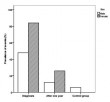Anemia in children and adolescents with inflammatory bowel disease at the time of diagnosis and after 1 year of treatment
Anemija pri otrocih in mladostnikih s kronično vnetno črevesno boleznijo ob diagnozi ter po enem letu zdravljenja
DOI:
https://doi.org/10.18690/actabiomed.115Keywords:
anemia, children, adolescents, prevalence, inflammatory bowel diseaseAbstract
Purpose: Purpose: Anemia is the most common systemic complication of inflammatory bowel disease (IBD). Depending on the diagnostic criteria and patient sub-population, the prevalence of anemia can be as high as 73.7%. Data suggest that the prevalence of anemia is often higher in the pediatric population than adults. The presence of anemia can have a significant impact on the quality of life (QOL) in patients with IBD, which can be as poor as exists in patients with advanced cancer; however, the QOL improves with restoration of the hemoglobin concentration. Because the anemia in patients with IBD is often unrecognized and/or undertreated, this potentially reversible condition is an area of great concern.
Methods: We retrospectively collected data for 44 pediatric patients (age range, 10–18 years; mean age, 14.3 years; 25 boys and 19 girls) at the time of diagnosis and after 1 year of IBD treatment and compared the IBD patients to 36 healthy children and adolescents (age range, 10–18 years; mean age, 13.7 years; 17 boys and 19 girls). We recorded the prevalence of anemia based on the World Health Organization criteria, the hemoglobin concentration, mean corpuscular volume, and iron and ferritin levels. We also compared IBD patients who were treated for anemia to untreated IBD patients.
Results: Anemia existed in 63% and 18% of IBD patients at the time of diagnosis and 1 year after treatment, respectively, and in 3% of the patients in the control group. Blood parameters in IBD patients improved after 1 year of treatment and approached the values in the control group. Of the IBD patients, 20% were treated for anemia. No statistical significance existed between IBD patients who were and were not treated for anemia.
Conclusion: Our findings suggest that anemia may improve in patients with IBD by treating the underlying
disease; however, we also found a small percentage of patients who were treated for anemia, which is an issue that must be kept in mind.
Downloads

Downloads
Published
Issue
Section
License
Copyright (c) 2015 Acta Medico-Biotechnica

This work is licensed under a Creative Commons Attribution 4.0 International License.